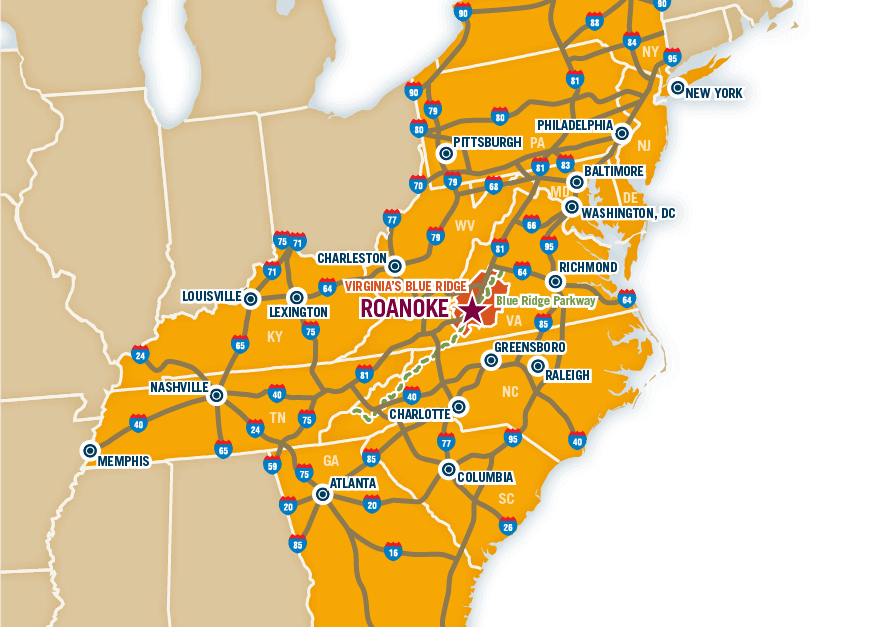As Robin Williams said, “Spring is nature’s way of saying ‘Let’s Party!’”
For bicycle enthusiasts living or visiting the Roanoke Valley in Virginia’s Blue Ridge, that means clipping in for a ride that doesn’t include long sleeves, long underwear and long nights.
With our recent spring forward time change, sunny skies extend well into the evening, making way for post work rides during the week and epically long outings on the weekend.
Whether you prefer twisting country roads or winding mountain trails, there are some simple spring tune-up techniques you should look into before heading out for that first ride of the season in Virginia’s Blue Ridge!
There are a plethora of bicycle specialty shops in Virginia’s Blue Ridge for you to choose from when it’s time to call in the experts. Starlight Bicycles, Cardinal Bicycle, UnderDog Bikes, East Coasters Bike Shops and others are your go-to experts for bike maintenance above and beyond your specific skill level. However, before you head to the shop, inspecting some of the common components that took a beating last year is a great idea.
1. Wash the Bike
It sounds obvious, but many of life’s cycling woes can be cured with a thorough bath, especially if the bike was dirty when you put it up last winter and you haven’t looked at it since!
Avoid high pressure nozzles, as they can force grime further into your components. Instead, use a gentle hose setting, a soapy sponge and a strong arm. Stiff bristled brushes can be useful to clear debris from the front chainrings and rear cassettes.
As you may expect, there are also numerous aftermarket cleaning tools available specific to every nook and cranny on a bicycle. Rinse and dry thoroughly.
2. Cabling & Housing
Checking the cables and the cable housing on your bike is quick and easy, and it could save you headaches on your first spring ride. First, check all cables for dirt and grime that have accumulated over the miles and clean off what you find.
Check all cable shifters and brake cables for responsive action. If you find a lag in the levers, run your hands down all the cabling and look for any dented or pinched housing, as well as any bends or kinks in the cables themselves. If you find any, it’s time to call the bike shop!
If everything checks out, place a couple drops of your preferred bicycle lube on your fingers and run them along the cables.
3. Brake Systems
Going flat out downhill is a good time, until you can’t stop. Giving your brakes a thorough onceover is never a bad idea.
Start with the levers. Check for free movement and responsive action. Next, check your brake pads. For those with v-brakes, this is a pretty simple task. For those with disk brakes, it may take a flashlight and a keen eye. Either way, if the pads are worn, now’s the time to replace.
If you have hydraulic braking systems, roll the bike forward and, with your weight on the handlebars, pull the brake levers. If the stopping action is weak, the lever feels especially squishy, or goes all the way in to the handlebar, it’s time to bleed the system—a procedure the skilled pros in Virginia’s Blue Ridge are very familiar with.
4. Chain Check
Constantly battling chain slip can be annoying and dangerous at times. There are a number of reasons why a chain is slipping off your chainrings under pedal pressure, but it’s always a good idea to rule out the chain itself.
Give the chain a good look and if it’s gummed up with dirt and grime, give it a thorough cleaning and lube. Next, check the chain wear.
There are relatively cheap tools for this (including a standard ruler), but you can get an idea of wear by shifting to the largest chainring in the front, the smallest on the rear cassette, and pulling the chain at the 3 o’clock position on the large chainring toward the front wheel. If it pulls away, you have some wear and may want a pro to check it out further.
5. Derailleurs & Pivot Points
Regardless of whether you are riding road or mountain, a bicycle’s front and rear derailleurs are constantly in demand. Shifting through the gears, especially those unintentional sloppy shifts on a tiring climb up the mountain, can be incredibly demanding on your derailleurs.
After a thorough cleaning and inspection for obvious imperfections, take a minute to lube all pivot points in the derailleurs to keep everything moving freely. If you are experienced enough, this is also when you can fine tune your shifting with some adjustments to your high stop and low stop limit screws.
However, this is also an excellent task for the experts. It sounds relatively simple and, in most cases, these adjustments can be, but it is amazing how smoothly a skilled professional can have your bicycle shifting after a quick adjustment.
6. Suspension Check
Front suspension forks vary greatly from model to model, but there are some basic steps to discovering and preventing wear and tear.
Start by applying the front brake and pushing the bike forward slightly. Look for any play or rocking in the fork, specifically where the fork tube enters the slider. If there is any play, consult a professional. Next, give all the suspension components, front and rear for full suspension, a close visual inspection.
You’re looking for leaking fork oil, rotting or cracking bushings, visual cracks in the fork crown, and scars or scratches on the fork tube. If you see any of these telltale signs, it's time to take your suspension components to a professional for a rebuild or replacement.
7. Tires & Wheels
Tires and wheels are components that can easily be neglected and overlooked. You see the tires time and time again. Unless you pay specific attention to signs like dry rotting along the rim edge, bulges in the sidewall or, in the case of off-road tires, knobs that have lost their edge, the need for a replacement set may go unnoticed.
Inflate to your normal riding pressure and give your tires a thorough visual check. For the wheels, place your bike in a stand or simply turn it upside down and gently rest the bike on the handlebars and seat. Spin the wheels. If you notice any wobble, it’s time to get your wheels trued. Feel out your spokes. You should have equal tension on all spokes around the wheel. Gently squeeze spokes a pair at a time to check for loose or broken spokes. Finally, grab the wheel at the 12 o’clock position and move the wheel side to side. There should be no play.
If your wheel inspections reveal any indications that repair is needed, it’s time to go to the pros.
Although these simple checks can get you on your way to a fun spring ride, it’s always best to let the experts put your bike to the test. Virginia’s Blue Ridge features some of the best road and mountain biking on the east coast, and we have the professionals to support any repair or adjustment you may need.
Plus, many local bicycle shops and lodgings offer bike rentals to give you the opportunity to test ride new bikes, or hit the trails on your next visit to the U.S. East Coast Mountain Biking Capital when you didn’t have room to pack the bike.
For a full list of popular rides and trails, bicycling itineraries, repair shops, unique gear and local riding groups, visit our newly launched Biking section. Check out our complete selection of Sample Itineraries and remember to subscribe to our monthly e-newsletter!
You can also get more biking tips by watching this video from Roanoke Mountain Adventures about what to take with you when mountain biking.












